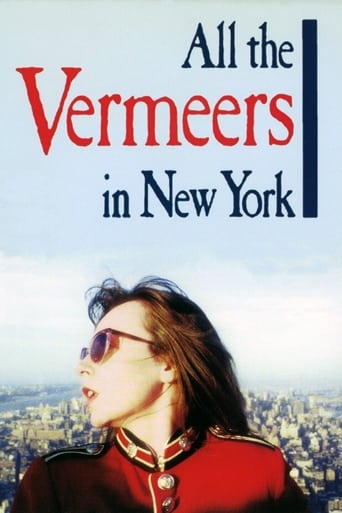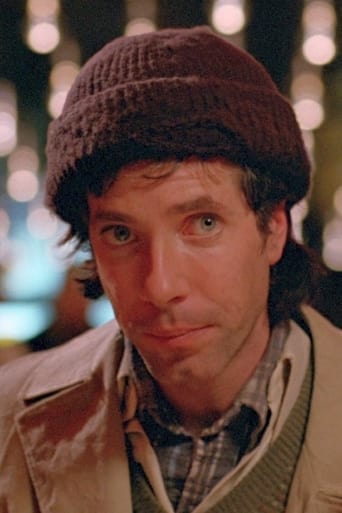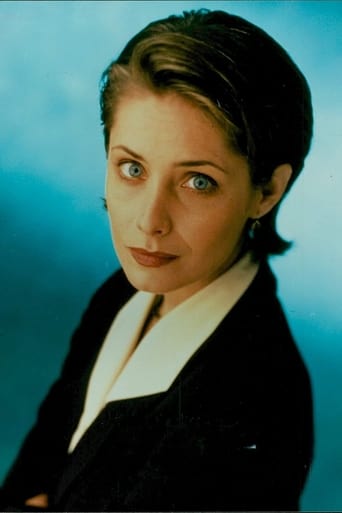A parable of the missteps of life enacted in the hothouse world of late 1980’s New York, in which the art market and the stock market each boomed, and in process spawned a smorgasbord of “yuppie” delusions which still persist. Anna, a French actress studying in New York, crosses paths with a successful stock-broker, Mark, standing before a Vermeer portrait at the Metropolitan, thence ensues a peculiar romance of missed meanings and connections, with tangential asides to the steaming arts world and stock market, loft-mate conflicts, and, perhaps, love. Wrapped up in their blindered worlds, Anna and Mark deflect away from their chances, leaving at the conclusion the wistful face of Vermeer’s portrait enigmatically asking questions. All the Vermeers in New York is a comedy of manners which, as gently as a Vermeer, looks beneath the skin of this time and place, and of these characters.
Reviews
One of my all time favorites.
Great Film overall
A lot of fun.
The film never slows down or bores, plunging from one harrowing sequence to the next.
The film begins with a static shot of the tops of buildings, turrets and spires, an unnamed city that looks old and European but eventually turns out to be Manhattan. Three young, pretty female roommates in a big apartment, one an aspiring actress, another a singer, the third involved in the art world. There's some cutesy, inconsequential dialogue; we are struck right away with the director's command of image, sound (particularly off-screen) and his exquisitely put together sets. Soon we move to an art gallery setting, a young man in a leather jacket arguing angrily with a dealer who is trying to sell his work -- will he be the protagonist? The film in its first couple of reels doesn't give us any answers here; the man leaves with a wealthy patron and potential buyer, but we don't follow them and move on instead to another a brief scene set in the financial world, as a broker or buyer of some kind (Stephen Lack) alternates between shouting about business and some kind of personal issues on the phone. Close on the heels of this scene, we enter another segment of the art world, as one of the roommates - aspiring French actress and student Anna (Emmanuelle Chaulet) is seen perusing the old masters - chiefly Rembrandt and Vermeer - at what turns out to be the Metropolitan Museum of Art, and is in turn perused by our stockbroker, who hands her a note at which point she leaves.This is the scene that introduces the spectacular and fairly indescribable avant-jazz/classical score by Jon English, one of the best soundtracks I've ever heard, and it also seems to introduce the rest of the film as we will now focus on these characters, and on the difficult lives they lead while being surrounded by and comforted by all the great art - photography, painting, music and architecture - that suffuses the film. An awkward scene in which Anna pretends to not speak English and is accompanied by her roommate Felicity (Grace Philips) as pretend-translator meets Mark (Lack) at a restaurant seems distancing and off-putting, and it seems very uncertain as to whether these two can -or should- meet again. There's also a very subtle and only briefly stated minor theme here about "home" and what it means; Mark is clearly Canadian and Anna French, and neither seems to really be comfortable - in Mark's case, with his profession and his inner life, in Anna's with America and perhaps her career.Is Mark some kind of creepy stalker? Is Anna a naive innocent, or is she planning on using the wealthy stockbroker for his money? The film never really answers these questions thoroughly, never really gets at what makes Mark so unhappy, why he even more than any of the characters actually working in the arts seems so attracted to beauty and culture; instead it peers obliquely in a few long scenes at the intersections, contemplating and watching, never telling. There is a gorgeous lengthy, probing tracking shot that traces an irregular path through the columns in the portico of the Met that seems to exist just to remind us of how beautiful, how stately and granitic art in the form of architecture can be, while the human beings are utterly frail and often incapable of ever reaching the transcendence in their own lives that they can in fact reach on canvas, in strings and percussion, in marble.I don't want to spoil the rather surprising ending, but I will add that what blew my mind even more than the finish of the film itself was learning that the entire film was improvised - on camera. Completely improvised; Jost says that he didn't have a story at all, really except that it had to involve art (a prerequisite of his funding), and he had the last shot in his head from the beginning. I found that out courtesy of his website, http://www.jon-jost.com/ where you can learn much more about this great but completely unknown American independent filmmaker, and buy some of his otherwise inaccessible films.I'd only seen one Jost film before, "Frameup" (1993) which had both the single most irritating character I've ever seen in a film and one of the most powerful and devastating endings I've experienced. On the basis of my memory of that film and this masterpiece, I definitely most see more. All the Vermeers had the widest release of any of Jost's films and might actually be available to some of you, and for its aesthetic pleasures alone - the beauty of the score which verges from neo-baroque to post-Ornette Coleman atonal free jazz, the beauty of the female cast and Chaulet in particular, the sumptuous art and sets, and the striking photography (in 35MM, as far as I know Jost's first in the format) I recommend this to anyone even remotely adventurous.Highest rating
Oh my GOD. This may just be the worst film I've ever seen. That it won awards anywhere seems to be a tribute to the "Emperor's New Clothes" school of film criticism. What a dreadful, film-school quality piece of junk. Endless shots of polished floors, marble-columned office-building lobbies, jet trails cutting across the clouds, all for nothing. NOTHING. And accompanied by a shatteringly harsh soundtrack.If anyone can tell me the point of the scene where the artist with the gambling problem tries to get an advance from a gallery owner, you will get a prize.Run, don't walk. Away, away, away!!
If you are a fan of independent and innovative filmmaking, this movie is for you. It's visuals are tremendous in their composition, movement, colors, etc. It's sense of editing and story progression is involving and thought provoking. This is the kind of movie that makes you forget traditional narrative expectations of "what will happen next?" or questions like "what is going on?" and instead prompts you to just experience, perceive, and feel the film. A must-see for anyone interested in non-traditional filmmaking and for anyone interested in a beautiful movie.
This is a great, beautiful, deep and rewarding film. Jost sets a slow pace that might frustrate some, but this film rewards patient attention. Jost understands the film medium and uses it to convey not just a story but a depth of meaning that could not be as effectively conveyed in another medium. The themes of love, loneliness, money, and art intertwine as the characters try to find meaning and break through barriers. Give this film the attention it deserves and you'll be glad you did.
Top Streaming Movies
















